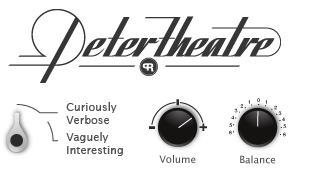Design is a Verb
 Amik, designed for the 1976 Montreal Olympic Games, George Huel, Yvon Laroche, Pierre-Yves Pelletier and Guy St-Arnaud.
Amik, designed for the 1976 Montreal Olympic Games, George Huel, Yvon Laroche, Pierre-Yves Pelletier and Guy St-Arnaud.
Seeing the documentary
Design Canada opened a bit of an old wound for me. One where I remembered that time in frustration I acted like a bit of a jerk. The film highlights the quality of graphic design work, primarily in the "international" or "Swiss" style. It showcases roughly a decade of Canadian design from the early 60s to the late 70s. Primarily the time just before Expo 67 and the time just after the 76 Montreal Olympics. This was a tremendously optimistic era for Canadians and several important symbols for Canada and Canadians came to life. In 1960 the Canadian National railway were convinced of needing an entire brand identity system and not just a logo. From those efforts came Allan Fleming's classic CN logo. Only a few years later a committee was struck to determine a new original flag design for Canada based on the maple leaf. By some miracle, a committee of politicians and bureaucrats actually choose a great design, which was later carefully crafted and fine tuned by a small design team.
These two designs seemed to be the beginning of a genuine emergence of talented designers making great work in Canada. Well, to be fair, talented European men who had come to Canada and worked from Toronto and Montreal. In most respects, this wave of talented immigrants and the work they did is the story of Canada. We are nothing if not a community of communities. In fact, I would stop there when describing any kind of Canadian Character or … ugh, I hate this expression but here goes, "Canadian Identity". Therein lies the salt in my old wound.
“…did these symbols, in fact, design Canada?”
When I studied design, almost the entire staff consisted off immigrant Canadians from places such as the UK, the Netherlands and Poland. It was great and really eye-opening for a Newfoundlander to meet and learn from these fine fellows. Except, it grew very tiring to hear of the golden age of Canadian Design (and in particular of the federal agency Design Canada - never mentioned in the film of the same name) as having come and gone. Yup. It was over. Oh those halcyon days were so fine and never to be repeated. Rather than imbue their students with the confidence to create from their own world view, they instilled a cynicism that took a generation of young Canadian designers to shed. I also grew very tired of having the Canadian Identity explained to me by these guys. There certainly is a truism that "newcomers" have a unique view of their adopted land and that is immensely valuable. Yet the view they had was one of the two solitudes of Protestant Ontario vs Catholic Quebec or even more succinctly put, TO vs MTL. The view of the teaching staff - even the Canadian born ones - was so incredibly myopic, they had no idea of the insult they gave every time they extolled the Canadian virtues embodied in maple syrup and Muskoka chairs. So, as a young man I routinely struck back. One thing I said then, to a particularly disagreeable Anglo-Canadian was that I was tired of "having a bunch of old European guys lecture me on what the Canadian Identity was". That came out wrong - I may have even been more forcibly insulting and said "old foreigners" - which was shamefully more xenophobic than ever intended. If a 20-year-old woke bi-racial woman asked "Why should a bunch of old white European men tell me what my identity is?" it would go viral today. That certainly wasn't the case then and in truth, I wasn't offended by "foreigners", but by Ontarian and Quebecois identities being offered as some kind of ethnic simulacrum of "Canadian Identity". What I really meant was I was fed up with "mainlanders" telling a Newfoundlander that to be Canadian was to drink beer while eating maple soaked bacon sitting on a rock in Northern Ontario, listening to Neil Young. Or as Brent Butt put it, the all-Canadian story is that of a Moose who wants to play in the NHL but his father wants him to take over the canoe factory. People in places like Newfoundland, Quebec, the Yukon or New Brunswick never really have to ask "what is the Canadian Identity?" because they know that is a telling question fielded largely in by Southern Ontarian media concerns.
 Parks Canada,c. 1970 Roderick Huggins.
Parks Canada,c. 1970 Roderick Huggins.
This attitude was distilled in a line from the documentary, "…did Canadians design these symbols or did these symbols, in fact, design Canada?" Okay, dear designer, climb down from thine lofty perch for a moment. Was the period from Expo to the Olympics a golden one? Undoubtably. Were these designers working at the highest level, creating some of the best graphic design anywhere in the world? Yes. Did those symbols create our identity as a nation? Not so fast, friend. I would agree that era, particularly after WWII, Canada was an optimistic, progressive, forward looking, history-unshackling place of nation builders with growing self-confidence. That socio-economic moment combined with a generation of designers who, as another designer in the film states, were essentially "Swissed" or worked in a very disciplined "International Style" led to that moment. To me, the fact that the CBC accepted a great modern icon or that the government commissioned and chose a really great icon for introducing the metric system was a reflection of a country that was forward looking and bold. The design activity of the time reflected our confidence and our imagined place in the world which in general is what we can say of most media, visual art, or literature created during any historical period. Compared to recent updates of the Ontario Trillium icon, the CBC logo or even the Parks Canada icon, which reflect a contemporary fad of "re-branding" and creating symbols designed to avoid offence, the graphic design of the 60s and 70s was bolder, more adventurous and more disciplined. When we see contemporary designs that look like they fell off of a clip art truck that reflects a lack of desire to pay someone the time to come up with something better or that the decision makers of those corporations lack the knowledge or resolve to make better decisions. If we are in some kind of current design doldrums (and who says we are) it may be more due to the abundance of branding firms doing so much work simply to justify their existence. Whatever the case, can we just stop calling what happens in Toronto and Montreal, our "Canadian Identity" because it never was, never should be and never will be.
Labels: architecture, art, design, movies




